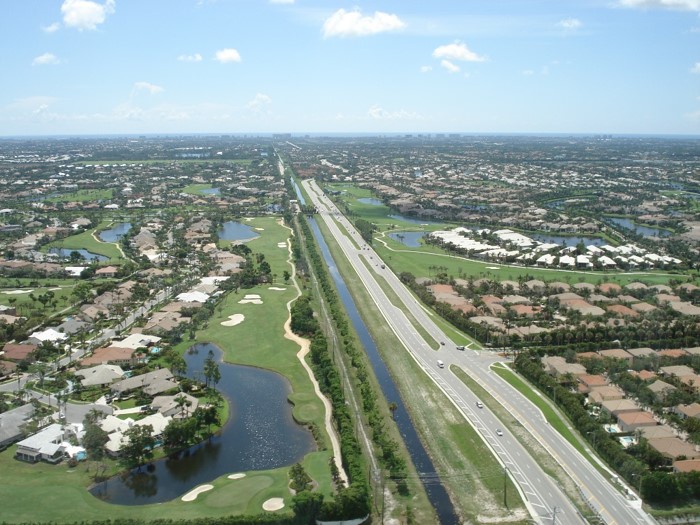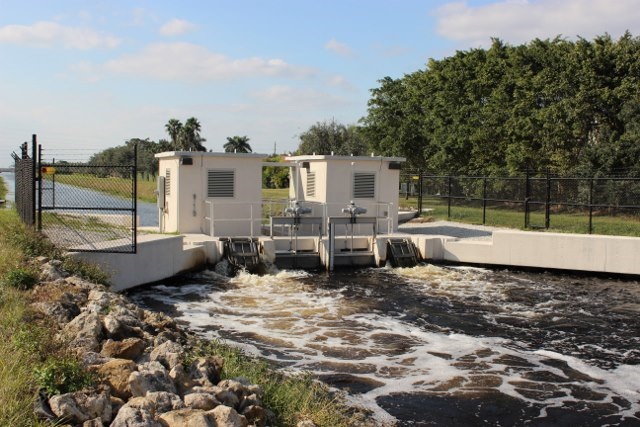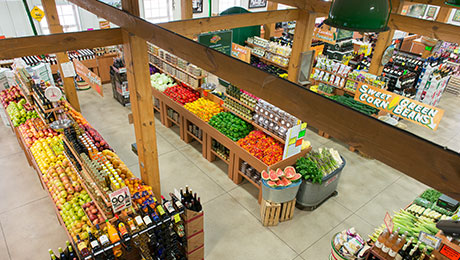Orrin Randolph's idea forever changed our landscape
|
|
 |
| Dredging of C. Stanley Weaver Canal |
 |
The District was established on June 15, 1915 with the mission
of reclaiming lands within its
boundary. Before 1915, a considerable amount of drainage work had been completed by the State, devel
opers,
private landowners a
nd
farmers. Although small drainage systems had been created, a cohesive long-term drainage plan was needed for the expansion
of the area we now know as southeastern Palm Beach County.
In the spring of 1916, Orrin Randolph, Chief Engineer for the newly created Lake Worth Drainage District, presented his first report to the Board of Supervisors. This report contained 127 pages detailing
the characteristics of the District and the means and methods for draining lands within its boundary. At that time, the District consisted of 129,317 acres of land and 3,400 acres of water. It was rectangular in shape and extended 26 miles in length and 8 miles in width. Population records of 1916 reported there were 6,500 owners of property within the District making the average land ownership equal to 20 acres per capita. Approximately
400 farmers were cultivating an estimated 5,000 acres.
|
|
 |
| Pineapple Farmers |
 |
Identified in the report were areas that could not be relied upon for agricultural uses. Randolph wrote,
"Provisions for artificial drainage would absolutely be necessary in order to provide a run-off rapid enough to prevent the
destruction of crops as a result of accumulated excess water on the land." The report proceeded to outline an
extensive interconnected systems of canals that would provide the drainage needed for future development. Thus, Randolph's report was adopted by the Board of Supervisors as the Plan of Reclamation with the understanding that the implementation of such a plan would forever change the landscape of this area.
|
|
Managing Water For Homeowners And Farmers
|
Flood control & water supply is a balancing act
 In the early years, agriculture dominated the area. However, rapid urbanization of the region began in the 1950's and has continued to the present day. The change in land use increased the quantity of rainfall runoff directed into the drainage system during wet periods. The State of Florida
created regional water management districts and implemented regulations to manage stormwater. Today, new development projects are required to construct stormwater lakes and ponds to receive and store excess rainfall. These practices enhance flood control efforts and avoid inundating local drainage networks. In the early years, agriculture dominated the area. However, rapid urbanization of the region began in the 1950's and has continued to the present day. The change in land use increased the quantity of rainfall runoff directed into the drainage system during wet periods. The State of Florida
created regional water management districts and implemented regulations to manage stormwater. Today, new development projects are required to construct stormwater lakes and ponds to receive and store excess rainfall. These practices enhance flood control efforts and avoid inundating local drainage networks.
 In the 1960's through the 1980's, water supply pumping stations were added to the water resource system of the District. These pumps work to maintain adequate groundwater recharge to support both agriculture and urban supplemental irrigation demands. This same system also recharges the aquifers that serve several municipal well fields in the region.
In the 1960's through the 1980's, water supply pumping stations were added to the water resource system of the District. These pumps work to maintain adequate groundwater recharge to support both agriculture and urban supplemental irrigation demands. This same system also recharges the aquifers that serve several municipal well fields in the region.
The need for quality flood control and adequate water supply must be balanced effectively. While excess water must by discharged for flood control, some water must be held back in storage to recharge the groundwater supply during dry periods. Additional information on how the District manages water can be found on our website at www.lwdd.net.
|
|
Within The District's Boundary
|
|
It's a great place to live and work
 |
|
 |
Farm in Delray Beach, Florida |
Agricultural production of the region's early settlers was just enough to feed themselves and the surrounding communities. However, it marked the beginning of a booming industry that would grow into a billion dollar economy and feed people around the world.
Since 1879, when the first tomato field was planted in the area now known as Lake Worth, Palm Beach County has been known as the
Winter Vegetable Capital of the United States. Two very different areas produce 26 major crops. The western area, often referred to as the "Glades" because the land was once part of the Everglades, hosts nutrient rich muck-soil famous for its sugar and rice production. In the eastern portion of the County mostly in or near Boynton Beach, Delray Beach, Boca Raton, Wellington, Jupiter, and Loxahatchee Groves, the sandy soil is excellent for growing vegetables and landscape vegetation.
|
|
 |
| Farming and development co-existing |
 |
Homeowners and farmers are sometimes at odds over land use, policy or management
practices. However more often, these two groups more often than not share a respect for each other and an appreciation for the lifestyle their co-existence fosters. For example, the term 'farm to table' is use widely in the restaurant industry increasing the market share for locally grown food and the ability to shop at a neighborhood farmer's market is an amenity coveted by many homebuyers. Living and working side by side, these two groups have created this highly desirable community we enjoy.
|
|
Water Manager's Lingo
|
|
Groundwater Recharge is a process where water moves downward from surface water to groundwater. Recharge is the primary method through which water enters an aquifer.
|
|
|
| August 17 Board of Supervisors Meeting |
| September 5 District Office Closed Happy Labor Day! |
| September 14 Board of Supervisors Meeting |
| LWDD Centennial Moment Video Series |
 National Farmers Market Week, Aug 7-13, 2016. Click photo for details. National Farmers Market Week, Aug 7-13, 2016. Click photo for details. |

Who owns the water within the drainage canals?
|
| Did You Enjoy this Issue? |
If you have any suggestions or comments on this issue, or have questions or topics you would like us to cover in future issues, please email us
[email protected].
|
|
|